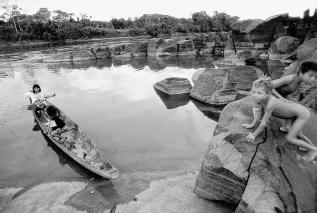1491 (53 page)

Such claims raise the hackles of many conservationists and ecologists. Amazonia, activists warn, is sliding toward catastrophe so rapidly that saving it must become a global priority. With bulldozers poised to destroy one of the planet’s last great wild places, environmentalists say, claiming that the basin comfortably housed large numbers of people for millennia is so irresponsible as to be almost immoral—it is tantamount to giving developers a green light.
The Amazon is
not
wild, archaeologists and anthropologists retort. And claiming that it is will, in its ignorance, worsen the ecological ailments that activists would like to cure. Like their confreres elsewhere in the Americas, Indian societies had built up a remarkable body of knowledge about how to manage and improve their environment. By denying the very possibility of such practices, these researchers say, environmentalists may hasten, rather than halt, the demise of the forest.
GREEN PRISON
The nineteenth-century naturalist Thomas Belt may have said it best. In what Darwin called “the best of all natural history journals,” Belt set down what has become the classic image of the tropical forest: a gigantic, teeming expanse, wildly diverse biologically but otherwise undifferentiated. “A ceaseless round of ever-active life weaves the forest scenery of the tropics into one monotonous whole,” as he put it. And since Belt’s day, terms like “Amazonia” and “Amazon basin” are often used as if they referred to a single, homogeneous entity.

AMAZON BASIN
This practice irritates professional geographers no end. Strictly speaking, “Amazon basin” refers to the drainage of the Amazon and its tributaries. “Amazonia,” by contrast, refers to the bigger region bounded by the Andes to the west, the Guiana Shield to the north, and the Brazilian Shield to the south. And neither is coterminous with the “Amazonian rainforest.” To begin with, not all of the “Amazonian rainforest” is rainy—parts of it receive little more precipitation per year than New York City. On top of that, about a third of Amazonia is not forest but savanna—the Beni, in Bolivia, is the biggest chunk. The river’s floodplain and that of its tributaries take up another 5 to 10 percent of the basin. Only about half of Amazonia is upland forest—vines overhead in a tangle like sailing ships rigged by drunks; tree branches in multiple layers; beetles the size of butterflies and butterflies the size of birds—the ecosystem that people outside the region usually mean when they say “Amazon.”
To biologists, the apparent fertility of the upland forest is a sham. This thesis was laid out clearly in Paul Richards’s classic 1952 study,
The Tropical Rain Forest.
To be sure, Richards said, the Amazon forest is uniquely diverse and beautiful. But its exuberant canopy is a mask covering an impoverished base. The base is the region’s poor soil. No matter what its original condition, the intense rain and heat of the forest have eroded its surface, washed out all its minerals, and decomposed vital organic compounds. As a result, much of the red Amazonian soil is weathered, harshly acid, and almost bereft of essential nutrients—one reason ecologists refer to the tropical forest as a “wet desert.”
Correspondingly, most nutrients in tropical forests are stored not in the soil, as in temperate regions, but in the vegetation that covers it. When leaves or branches fall, the carbon and nitrogen in the debris are rapidly reabsorbed by the hyperefficient root systems of tropical plants. If loggers or farmers clear away the vegetation, they also remove the local supply of nutrients. Normally the forest quickly fills in bare spots, such as those created when big trees fall, and damage is kept to a minimum. But if the opening is too large or the ground is kept clear too long, the sun and rain decompose whatever organic matter remains and bake the surface into something resembling brick in both color and impermeability. In short order, the land becomes almost incapable of sustaining life. Thus the tropical forest, despite its fabulous vitality, exists on a knife edge.
These views were picked up and amplified in
Amazonia: Man and Culture in a Counterfeit Paradise,
by Betty J. Meggers, the Smithsonian archaeologist. Published in 1971, it may be the most influential book ever written about the Amazon. Agriculture, Meggers pointed out, depends on extracting the wealth of the soil. With little soil wealth to extract, she said, Amazonian farmers face inherent ecological limitations. The only form of agriculture they can practice for a long time is “slash-and-burn,” or “swidden,” as it is sometimes known. Farmers clear small fields with axes and machetes, burn off the chaff and refuse, and plant their seeds. The ash gives the soil a quick shot of nutrients, giving the crop a chance. As the crops grow, the jungle rapidly returns—weeds first, then fast-growing tropical trees. In the few years before forest recovers the plot, farmers can eke something out of the land.
Slash-and-burn, Meggers told me, is “a superb response to ecological limits.” Farmers grab a few harvests, but the soil is not bared to rain and sun long enough to incur permanent damage. Switching from field to field to field, swidden farmers live in the forest without destroying the ecosystems they depend on: a supple, balanced harmony. This ancient lifeway survives today, according to this theory, in the ring-shaped compounds of the Yanomamo. (Most of the Yanomamo actually live around South America’s
other
huge river system, the Orinoco, but they are seen as emblematic of Amazonia as well.) Gliding nearly nude beneath the trees, cultivating their temporary gardens, the Yanomamo are often said to be windows into the past, living much the same lives as their great-great-great-grandparents. Their long-term existence has not damaged the forest, Meggers told me, a testament to slash-and-burn’s power to keep human groups sustainably within the rigid ecological limits of the tropics.
A second reason that slash-and-burn is required, Meggers told me, is the region’s propensity for suffering “mega-Niño events”—superstrong El Niño climate swings that occur every three hundred to five hundred years. In the archaeological record, she said, “We’re able to pick up severe droughts related to these mega-Niño events. What these did was reduce the food supply. The 1998 El Niño was a small example—they saw droughts, forest fires, and reduction of resources from when trees don’t flower.” Forest fires in the northern state of Roraima that year claimed such a huge area that Brazil requested aid from the United Nations. In the past, Meggers said, “the well-established groups that were sitting in one territory for several hundred years couldn’t survive [the droughts], so they broke up. We see this repeated at least four times in the last two millennia.” In other words, any Indians who tried to go beyond slash-and-burn to permanent cultivation would be knocked back to slash-and-burn by a mega-Niño. Slash-and-burn, she said, “avoids the risks, including the risk of growth—it’s the smart thing to do.”

Ethnographic celebrities, the Yanomamo are often portrayed as windows into the past, inhabitants of a forest wilderness they have inhabited, almost unchanged, for millennia. Recent studies have cast doubt on this picture. Indeed, the Yanomamo are relative newcomers to their homeland, many of them moving there only in the seventeenth century as they fled European diseases and cruelty further south. Some scholars believe their societies were originally so much larger and more materially complex that what is often pictured as an almost idyllic, “natural” existence is in fact a life in poor exile.
Swidden, Meggers admitted, has a major drawback: it cannot yield enough to support a complex society. More intensive farming might produce the requisite surplus, but cannot be sustained; the plowed land, exposed to the elements, is destroyed in as little as a decade. Even with slash-and-burn, ecologists say, the forest can take as much as a hundred years to return completely to its previous state. European-style agriculture would not only fall victim to mega-Niños, it would permanently ruin the forest soils.
Carvajal therefore misunderstood what he saw, Meggers told me. Or else he had simply made up
everything,
and not just the Amazons. Caught in a lush, green trap, Indian villages could not possibly have grown as large as he reported—indeed, Meggers once proposed an upper limit of a thousand on their population. And the villages could not have been the sophisticated places he described, with their chiefly rulers, social classes, and specialized laborers (those military musicians on the Tapajós, for example). That was why archaeologists and anthropologists had come across the ruins of complex societies throughout Mesoamerica and the Andes, but saw only hunter-gatherers and slash-and-burners in Amazonia.
“The basic thing about the Amazon is that these people had a long-term period to learn about and experience and benefit from their knowledge of the environment,” Meggers said. “Any group that over-exploited their environment was going to be dead. The ones that survived, the knowledge got built into their ideology and behavior with taboos and other kinds of things.” Having reached the optimal cultural level for their environment, she explained, Amazon Indian lives changed little, if at all, for at least two thousand years.
As proof, Meggers pointed to Marajó, an island more than twice the size of New Jersey that sits like a gigantic stopper in the mouth of the Amazon. The island, low and often swampy, is created by the collision of the Amazon with the sea, which forces the river to disgorge dissolved sediments. Much of the island is submerged during the rainy season, and even in the dry summer pieces of the mazy shoreline are constantly calving off like icebergs and falling into the water. Yet despite the unpromising setting, the Marajóara created a sophisticated society there from about 800 to 1400
A.D.
The island’s pottery, some of it very large, has long been celebrated for its painted and incised representations of animals and plants, which are ornately entangled in a profusion that recalls the forest itself. The skillful pottery indicated that Marajó was a large-scale society—the only one then known in all of Amazonia. In the late 1940s Meggers and her husband, archaeologist Clifford J. Evans, decided to learn more.
The decision was ambitious. Archaeologists have traditionally avoided tropical forests, because the climate destroys all wood, cloth, and organic material—except for ceramics and stone, there is little left to dig up. And the Amazon basin, essentially an astoundingly large river valley made of deposited mud, has almost no stone, so archaeologists wouldn’t even find that. (Because the nearest deposits of metal ore were in the Andes, thousands of miles upstream, Amazonian peoples had no metal.)
At Marajó, Meggers and Evans soon noticed an oddity: the earliest traces of Marajóara culture were the most elaborate. As the centuries advanced, the quality of the ceramics inexorably declined. The designs became cruder, the repertoire of themes reduced, the technical skill diminished. At the beginning, some grave sites were more elaborate than others, a testament to social stratification. Later on, all the dead were treated in the same mundane way. Early in their history, the Marajóara must have sneered at the lowly cultures on their borders. But as the forest, in a process out of
Heart of Darkness,
stripped away the layers of civilization, they became indistinguishable from their neighbors. A hundred years before Columbus, Meggers told me, they were blasted by a mega-Niño and then overrun by one of their erstwhile inferiors. The history of Marajó was all fall and no rise.
